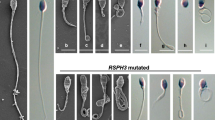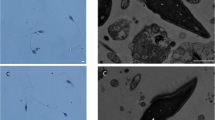Abstract
Purpose
Sperm-borne PLCζ protein induces Ca2+ oscillations in the oocyte and is believed to play a major role during oocyte activation. However, its implication in fertilization failure following ICSI is still debated. We analyzed PLCζ gene sequence, protein expression level, and localization in both patients with previous failed fertilization by ICSI and sperm donors with proven fertility in order to assess the association of PLCζ with both sperm characteristics and ability to fertilize.
Methods
Semen from 15 patients and 13 sperm donors with proven fertility was included in the study. Analysis of the PLCζ gene sequence, protein expression through Western blot, and protein localization by immunofluorescence were performed.
Results
Two patients with total fertilization failure presented mutations in heterozygosis in the PLCζ gene. Comparison with donor sample sequences displayed comparable SNP allele frequency. Distribution pattern of PLCζ did not vary significantly between donor and patient samples. Levels of PLCζ protein in sperm cells showed an interindividual variability both in patient and donor samples. Several SNPs previously reported in infertile patients were also present in fertile men.
Conclusion
Failed fertilization occurs even when levels and distribution of PLCζ protein are within normal range. PLCζ seems to be a necessary but not sufficient factor in determining the molecular pathway involved in oocyte activation.




Similar content being viewed by others
References
Gadella BM, Evans JP. Membrane fusions during mammalian fertilization. Adv Exp Med Biol. 2011;713:65–80. doi:10.1007/978-94-007-0763-4_5.
Kline D, Kline JT. Repetitive calcium transients and the role of calcium in exocytosis and cell cycle activation in the mouse egg. Dev Biol. 1992;149(1):80–9.
Swann K. A cytosolic sperm factor stimulates repetitive calcium increases and mimics fertilization in hamster eggs. Development. 1990;110(4):1295–302.
Stricker SA. Comparative biology of calcium signaling during fertilization and egg activation in animals. Dev Biol. 1999;211(2):157–76. doi:10.1006/dbio.1999.9340.
Jones KT, Nixon VL. Sperm-induced Ca(2+) oscillations in mouse oocytes and eggs can be mimicked by photolysis of caged inositol 1,4,5-trisphosphate: evidence to support a continuous low level production of inositol 1,4,5-trisphosphate during mammalian fertilization. Dev Biol. 2000;225(1):1–12. doi:10.1006/dbio.2000.9826.
Rice A, Parrington J, Jones KT, Swann K. Mammalian sperm contain a Ca(2+)-sensitive phospholipase C activity that can generate InsP(3) from PIP(2) associated with intracellular organelles. Dev Biol. 2000;228(1):125–35. doi:10.1006/dbio.2000.9929.
Saunders CM, Larman MG, Parrington J, Cox LJ, Royse J, Blayney LM, et al. PLC zeta: a sperm-specific trigger of Ca(2+) oscillations in eggs and embryo development. Development. 2002;129(15):3533–44.
Cox LJ, Larman MG, Saunders CM, Hashimoto K, Swann K, Lai FA. Sperm phospholipase Czeta from humans and cynomolgus monkeys triggers Ca2+ oscillations, activation and development of mouse oocytes. Reproduction. 2002;124(5):611–23.
Rogers NT, Hobson E, Pickering S, Lai FA, Braude P, Swann K. Phospholipase Czeta causes Ca2+ oscillations and parthenogenetic activation of human oocytes. Reproduction. 2004;128(6):697–702. doi:10.1530/rep.1.00484.
Yoneda A, Kashima M, Yoshida S, Terada K, Nakagawa S, Sakamoto A, et al. Molecular cloning, testicular postnatal expression, and oocyte-activating potential of porcine phospholipase Czeta. Reproduction. 2006;132(3):393–401. doi:10.1530/rep.1.01018.
Ito M, Shikano T, Kuroda K, Miyazaki S. Relationship between nuclear sequestration of PLCzeta and termination of PLCzeta-induced Ca2+ oscillations in mouse eggs. Cell Calcium. 2008;44(4):400–10.
Kouchi Z, Fukami K, Shikano T, Oda S, Nakamura Y, Takenawa T, et al. Recombinant phospholipase Czeta has high Ca2+ sensitivity and induces Ca2+ oscillations in mouse eggs. J Biol Chem. 2004;279(11):10408–12. doi:10.1074/jbc.M313801200.
Yu Y, Halet G, Lai FA, Swann K. Regulation of diacylglycerol production and protein kinase C stimulation during sperm- and PLCzeta-mediated mouse egg activation. Biol Cell. 2008;100(11):633–43. doi:10.1042/BC20080033.
Ross PJ, Beyhan Z, Iager AE, Yoon SY, Malcuit C, Schellander K, et al. Parthenogenetic activation of bovine oocytes using bovine and murine phospholipase C zeta. BMC Dev Biol. 2008;8:16. doi:10.1186/1471-213X-8-16.
Ross PJ, Rodriguez RM, Iager AE, Beyhan Z, Wang K, Ragina NP, et al. Activation of bovine somatic cell nuclear transfer embryos by PLCZ cRNA injection. Reproduction. 2009;137(3):427–37. doi:10.1530/REP-08-0419.
Kashir J, Jones C, Lee HC, Rietdorf K, Nikiforaki D, Durrans C, et al. Loss of activity mutations in phospholipase C zeta (PLCzeta) abolishes calcium oscillatory ability of human recombinant protein in mouse oocytes. Hum Reprod. 2011;26(12):3372–87. doi:10.1093/humrep/der336.
Yoon SY, Eum JH, Lee JE, Lee HC, Kim YS, Han JE, et al. Recombinant human phospholipase C zeta 1 induces intracellular calcium oscillations and oocyte activation in mouse and human oocytes. Hum Reprod. 2012;27(6):1768–80. doi:10.1093/humrep/des092.
Nomikos M, Blayney LM, Larman MG, Campbell K, Rossbach A, Saunders CM, et al. Role of phospholipase C-zeta domains in Ca2+-dependent phosphatidylinositol 4,5-bisphosphate hydrolysis and cytoplasmic Ca2+ oscillations. J Biol Chem. 2005;280(35):31011–8. doi:10.1074/jbc.M500629200.
Knott JG, Kurokawa M, Fissore RA, Schultz RM, Williams CJ. Transgenic RNA interference reveals role for mouse sperm phospholipase Czeta in triggering Ca2+ oscillations during fertilization. Biol Reprod. 2005;72(4):992–6. doi:10.1095/biolreprod.104.036244.
Yoon SY, Jellerette T, Salicioni AM, Lee HC, Yoo MS, Coward K, et al. Human sperm devoid of PLC, zeta 1 fail to induce Ca(2+) release and are unable to initiate the first step of embryo development. J Clin Invest. 2008;118(11):3671–81. doi:10.1172/JCI36942.
Heytens E, Parrington J, Coward K, Young C, Lambrecht S, Yoon SY, et al. Reduced amounts and abnormal forms of phospholipase C zeta (PLCzeta) in spermatozoa from infertile men. Hum Reprod. 2009;24(10):2417–28. doi:10.1093/humrep/dep207.
Nomikos M, Elgmati K, Theodoridou M, Calver BL, Cumbes B, Nounesis G, et al. Male infertility-linked point mutation disrupts the Ca2+ oscillation-inducing and PIP(2) hydrolysis activity of sperm PLCzeta. Biochem J. 2011;434(2):211–7. doi:10.1042/BJ20101772.
Kashir J, Konstantinidis M, Jones C, Lemmon B, Lee HC, Hamer R, et al. A maternally inherited autosomal point mutation in human phospholipase C zeta (PLCzeta) leads to male infertility. Hum Reprod. 2012;27(1):222–31. doi:10.1093/humrep/der384.
Esfandiari N, Javed MH, Gotlieb L, Casper RF. Complete failed fertilization after intracytoplasmic sperm injection—analysis of 10 years’ data. Int J Fertil Womens Med. 2005;50(4):187–92.
Flaherty SP, Payne D, Matthews CD. Fertilization failures and abnormal fertilization after intracytoplasmic sperm injection. Hum Reprod. 1998;13 Suppl 1:155–64.
Rawe VY, Olmedo SB, Nodar FN, Doncel GD, Acosta AA, Vitullo AD. Cytoskeletal organization defects and abortive activation in human oocytes after IVF and ICSI failure. Mol Hum Reprod. 2000;6(6):510–6.
Meerschaut FV, Giorgetti C, De Sutter P. First-trimester Down syndrome screening after assisted conception. Fertil Steril. 2014;101(3):e18. doi:10.1016/j.fertnstert.2013.12.036.
Taylor SL, Yoon SY, Morshedi MS, Lacey DR, Jellerette T, Fissore RA, et al. Complete globozoospermia associated with PLCzeta deficiency treated with calcium ionophore and ICSI results in pregnancy. Reprod Biomed Online. 2010;20(4):559–64. doi:10.1016/j.rbmo.2009.12.024.
Lee HC, Arny M, Grow D, Dumesic D, Fissore RA, Jellerette-Nolan T. Protein phospholipase C Zeta1 expression in patients with failed ICSI but with normal sperm parameters. J Assist Reprod Genet. 2014;31(6):749–56. doi:10.1007/s10815-014-0229-9.
Durban M, Barragan M, Colodron M, Ferrer-Buitrago M, De Sutter P, Heindryckx B, et al. PLCzeta disruption with complete fertilization failure in normozoospermia. J Assist Reprod Genet. 2015;32(6):879–86. doi:10.1007/s10815-015-0496-0.
Grasa P, Coward K, Young C, Parrington J. The pattern of localization of the putative oocyte activation factor, phospholipase Czeta, in uncapacitated, capacitated, and ionophore-treated human spermatozoa. Hum Reprod. 2008;23(11):2513–22. doi:10.1093/humrep/den280.
Kashir J, Jones C, Mounce G, Ramadan WM, Lemmon B, Heindryckx B, et al. Variance in total levels of phospholipase C zeta (PLC-zeta) in human sperm may limit the applicability of quantitative immunofluorescent analysis as a diagnostic indicator of oocyte activation capability. Fertil Steril. 2013;99(1):107–17. doi:10.1016/j.fertnstert.2012.09.001.
Yelumalai S, Yeste M, Jones C, Amdani SN, Kashir J, Mounce G, et al. Total levels, localization patterns, and proportions of sperm exhibiting phospholipase C zeta are significantly correlated with fertilization rates after intracytoplasmic sperm injection. Fertil Steril. 2015. doi:10.1016/j.fertnstert.2015.05.018.
Neri QV, Lee B, Rosenwaks Z, Machaca K, Palermo GD. Understanding fertilization through intracytoplasmic sperm injection (ICSI). Cell Calcium. 2014;55(1):24–37. doi:10.1016/j.ceca.2013.10.006.
Krog M, Prior M, Carlsen E, Loft A, Forman J, Pinborg A, et al. Fertilization failure after IVF in 304 couples—a case-control study on predictors and long-term prognosis. Eur J Obstet Gynecol Reprod Biol. 2015;184:32–7. doi:10.1016/j.ejogrb.2014.10.037.
Sosnik J, Buffone MG, Visconti PE. Analysis of CAPZA3 localization reveals temporally discrete events during the acrosome reaction. J Cell Physiol. 2010;224(3):575–80. doi:10.1002/jcp.22211.
Geyer CB, Inselman AL, Sunman JA, Bornstein S, Handel MA, Eddy EM. A missense mutation in the Capza3 gene and disruption of F-actin organization in spermatids of repro32 infertile male mice. Dev Biol. 2009;330(1):142–52. doi:10.1016/j.ydbio.2009.03.020.
Escoffier J, Yassine S, Lee HC, Martinez G, Delaroche J, Coutton C, et al. Subcellular localization of phospholipase Czeta in human sperm and its absence in DPY19L2-deficient sperm are consistent with its role in oocyte activation. Mol Hum Reprod. 2015;21(2):157–68. doi:10.1093/molehr/gau098.
Kuentz P, Vanden Meerschaut F, Elinati E, Nasr-Esfahani MH, Gurgan T, Iqbal N, et al. Assisted oocyte activation overcomes fertilization failure in globozoospermic patients regardless of the DPY19L2 status. Hum Reprod. 2013;28(4):1054–61. doi:10.1093/humrep/det005.
Escoffier J, Lee HC, Yassine S, Zouari R, Martinez G, Karaouzene T, et al. Homozygous mutation of PLCZ1 leads to defective human oocyte activation and infertility that is not rescued by the WW-binding protein PAWP. Hum Mol Genet. 2016;25(5):878–91. doi:10.1093/hmg/ddv617.
Acknowledgments
We would like to thank the embryology laboratory technical staff from Clínica Eugin for their help in sample handling and Désirée García for statistical support.
Author information
Authors and Affiliations
Corresponding author
Ethics declarations
Competing interests
The authors declare that they have no conflict of interest.
Additional information
Capsule PLCζ seems to be a necessary but not sufficient factor in determining the molecular pathway involved in oocyte activation.
Electronic supplementary material
Below is the link to the electronic supplementary material.
Supplementary Table 1
Sperm parameters from patients. (DOCX 15 kb)
Supplementary Table 2
Sperm parameters from donors. (DOCX 14 kb)
Supplementary Table 3
Expression of PLCz in patient samples expressed as a percentage of cells. (DOCX 26 kb)
Supplementary Table 4
Expression of PLCz in donor samples expressed as a percentage of cells. (DOCX 21 kb)
Supplementary Table 5
p values of statistical significance for comparison of distribution patters of PLCz in patients and donors. p ≤ 0.01. (DOCX 17 kb)
Supplementary Table 6
Pearson correlation between sperm parameters (motility/ concentration) and distribution patterns of PLCz within the sperm cell. (DOCX 16 kb)
Supplementary Fig. 1
Image of the full blots used to elaborate Fig. 4. Western Blots showing PLCζ and tubulin expression in total protein lysates of donor (upper panels) and patient (lower panels) samples. P = patient; D = donor. Blots were run in different days, loading D6 and D7 donors in blot from patients as an internal technical control. Red squares mark the region of the blot used to prepare Fig. 4. (GIF 331 kb)
High resolution image
(TIF 1539 kb)
Rights and permissions
About this article
Cite this article
Ferrer-Vaquer, A., Barragan, M., Freour, T. et al. PLCζ sequence, protein levels, and distribution in human sperm do not correlate with semen characteristics and fertilization rates after ICSI. J Assist Reprod Genet 33, 747–756 (2016). https://doi.org/10.1007/s10815-016-0718-0
Received:
Accepted:
Published:
Issue Date:
DOI: https://doi.org/10.1007/s10815-016-0718-0




